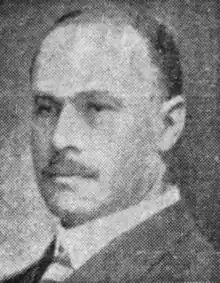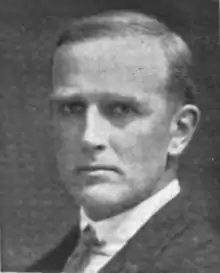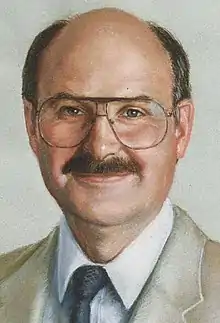| Leader of the Opposition of British Columbia | |
|---|---|
| Inaugural holder | James Alexander MacDonald |
The leader of the Opposition (French: chef de l'Opposition) in British Columbia is the member of the Legislative Assembly (MLA) in the Legislative Assembly of British Columbia who leads the political party recognized as the Official Opposition. This position generally goes to the leader of the largest party in the Legislative Assembly that is not in government.
Notes
- ↑ Ordinal number based on first term served by each unique person. Letter suffixes indicate first and second terms of those serving more than once.
- 1 2 Did not sit in the Legislature as leader of the Official Opposition
- 1 2 The 1909 election saw four opposition members, two Liberals and two Socialists, elected. As seats were assigned by alphabetical order, Hawthornthwaite physically occupied the seat typical of the Opposition leader. Hawthornthwaite initially rejected the idea of being leader, but was later reported to have "assumed the functions of Opposition leader". However, by the next session, Brewster was being referred to as Opposition leader.[2]
- ↑ Declined to be named Opposition leader, but was referred to as such by the media and received the appropriate salary.[2]
- ↑ Became Opposition leader mid-legislature after by-election victories.[2]
- ↑ After party leader William John Bowser lost his seat in the 1924 election, house leader Robert Henry Pooley became leader of the Opposition. In 1926 Simon Fraser Tolmie was elected Conservative leader but he did not seek a seat in the legislature until the 1928 provincial election, which his party won.
- ↑ Connell was exeplled from the CCF in 1936 for opposing party policy. He and three other CCF MLAs formed the "Social Reconstructive" party. With a total of 4 MLAs compared to 3 remaining in the CCF, Connell's new party was the second largest in the legislature allowing him to retain the title of "leader of the Official Opposition".
- ↑ Anscomb's Conservatives had been part of a coalition government with the Liberals until late 1951 when the Liberals decided to terminate the arrangement and Premier John Hart dropped his Conservative ministers from Cabinet. The Tories moved to the opposition benches and displaced the CCF to form the Official Opposition from February 1952 until the June 1952 provincial election.
- ↑ The CCF became the NDP in 1961 as a result of the creation of the federal New Democratic Party.
- ↑ Barrett lost his seat in the December 1975 general election and re-entered the legislature through a June 1976 by-election. William Stewart King acted as leader of the Opposition in the house in the interim. Barrett continued as leader of the party during this period.
- ↑ Although Gordon Campbell refused to recognize the NDP as an official party since it lacked the number of seats required for official party status, the Speaker recognized MacPhail as Opposition leader and ensured the NDP received the resources and funding due to the party's status as the Official Opposition.
References
- ↑ "Leaders of the Official Opposition of British Columbia" (PDF). Legislative Library of British Columbia. 21 December 2018. Retrieved 16 August 2020.
- 1 2 3 "Leaders of the Opposition in British Columbia 1903-" (PDF). Legislative Library of British Columbia. 25 January 2011. Archived from the original (PDF) on 20 February 2011. Retrieved 16 August 2020.
This article is issued from Wikipedia. The text is licensed under Creative Commons - Attribution - Sharealike. Additional terms may apply for the media files.
.jpg.webp)
.jpg.webp)


.jpg.webp)

.jpg.webp)




.jpg.webp)
.jpg.webp)



.jpg.webp)


_(cropped).jpg.webp)
.jpg.webp)



